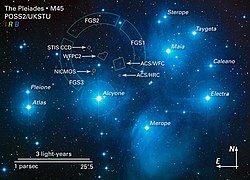Electra (star)
| Observation data Epoch J2000 Equinox J2000 |
|
|---|---|
| Constellation | Taurus |
| Right ascension | 03h 44m 52.5373s |
| Declination | +24° 06′ 48.021″ |
| Apparent magnitude (V) | 3.705 |
| Characteristics | |
| Spectral type | B6 IIIe |
| U−B color index | -0.40 |
| B−V color index | -0.12 |
| Astrometry | |
| Radial velocity (Rv) | +10.9 km/s |
| Proper motion (μ) |
RA: 21.55 mas/yr Dec.: -44.92 mas/yr |
| Parallax (π) | 5.72 ± 1.05mas |
| Distance | approx. 600 ly (approx. 170 pc) |
| Details | |
| Surface gravity (log g) | 3.412 ± 0.047 cgs |
| Temperature | 13,484 ± 293 K |
| Rotation | v sin i = 181 km/s |
| Age | 1.15 × 108 years |
| Other designations | |
Electra, also designated 17 Tauri, is a blue-white giant star in the constellation of Taurus. The star is one of the nine brightest stars in the Pleiades open star cluster (M45). The most visible stars in this group are named for the Seven Sisters of Greek mythology.
The star has an apparent brightness of 3.72, the third-brightest of the stars in the group. Electra belongs to the spectral class B6 IIIe and is approximately 370 light-years from the Sun. Electra is one of the four Pleiades stars that is classed as a giant; one that is starting to expand as the internal hydrogen fuel in the core is exhausted.
The projected rotational velocity of this star is 181 km/s, making it a fast rotator. This is the velocity component of the star's equatorial rotation along the line of sight to the Earth. The estimated inclination of the star's pole is 46.8° ± 1.6, giving it a true equatorial rotational velocity of 320 ± 18 km/s. The rapid rotation rate of this star flattens the poles and stretch the equator. This makes the surface gravity of the star non-uniform and causes temperature variation. This effect is known as gravity darkening, because it results in a variation of radiation by latitude. The rapid rotation extends the life span of the star by increasing the core density and reducing the radiation output.
This is classified as a Be star, which is a B-type star with prominent emission lines of hydrogen in its spectrum. The Be stars have a rotation rate that is 1.5–2 times the rotation of normal B-type stars. This high rate of rotation may allow mass loss during even minor prominences. Changes in the radial velocity measurements indicate that this star may have a companion, which would make Electra a spectroscopic binary.
...
Wikipedia

